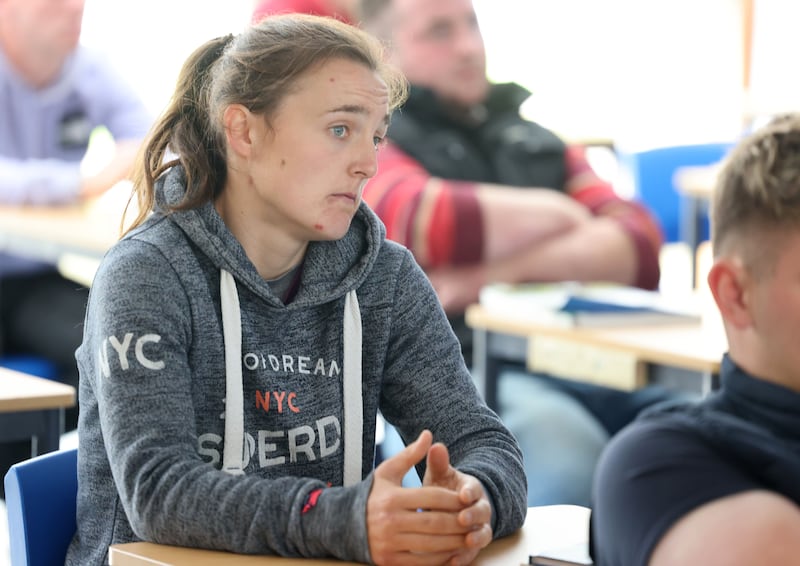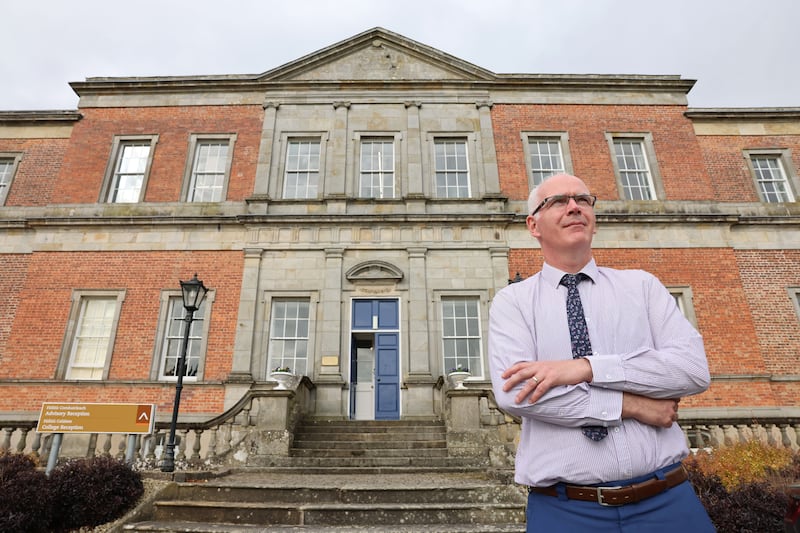A sense of duty prompted Francis Rowley (19) to enrol in Teagasc’s Ballyhaise Agricultural College, Co Cavan.
“I just love farming,” he says, arms folded, leaning back into his chair. “My grandfather worked so hard to get the farm we have. My father works very hard to keep it going too, so I’d feel bad if I didn’t take it up.”
The second-year Level 6 Advanced Cert in Agriculture student from Killoe, Co Longford, is sitting in a room within the college’s main building, a grand structure dating back to the 1700s, set among rolling drumlins and lush fields and forestry.

Sitting across the table, Emma Cullen (30), another second-year from Mountnugent, Co Cavan, reflects on her journey in farming. She worked an office job for nine years before deciding it was time to pursue a career in agriculture.
“I’ve always had the passion for farming, so it’s really only in the last two or three years that I’ve pursued that a bit more,” she says.

That passion comes from her father: “Growing up, going to marts, going to agricultural shows.”
While the pull of generational farming has fixed both Rowley and Cullen on their current paths, the sector they are entering is much changed from decades before.
Ahead of the National Ploughing Championships in Ratheniska, Co Laois, next week, several young people spoke to The Irish Times about what it means to be a young farmer today. Among them, there is a consensus that a spiralling climate crisis demands a change in behaviours within the agricultural sector.
[ The critical distinction between ‘nature restoration’ and ‘rewilding’Opens in new window ]
Keeping up to date with the challenge at hand, educators at Ballyhaise have shifted the focus of their curriculum across the board.
“There was always a focus on profit per hectare,” John Kelly, the principal at Ballyhaise, says, sitting in the canteen of the college last week. “We’ve always had a focus historically to look at your profit per hectare of land, because that’s how you make a living off the land.”

In the past five years, the college has changed tack, says Kelly. Prior to the pandemic, he was asked to give a speech to some young people at Cavan Library about the human impact on the planet, and specifically the role of industry in Ireland in causing climate change.
“I think that was a real moment for me, because I was able to see young people’s genuine anxiety and concerns about the impacts that humans were having,” he says.
“For me then, it was to look at what we’re doing here in the college, and to make sure that we were also going to start implementing changes that would complement the profit per hectare, productivity of the farm, with actions that would reduce our footprint.”
Government emission targets have helped to put a definite shape on this new teaching approach.
The Government’s Climate Action Plan 2023, published last December, provided a goal for Irish farmers to work towards, and informs much of the teaching at Ballyhaise. The agricultural sector has been tasked with reducing carbon emissions by 25 per cent by 2030.
One of the questions that educators in Ballyhaise, a Teagasc institution are trying to answer now is: what action do we take?
[ No talk ‘on the ground’ by farmers about a new political party, says MinisterOpens in new window ]
The Climate Action Plan notes that, in order for the agricultural sector to meet its emission targets in 2030, a significant reduction in nitrous oxide emissions caused by the industry is required.
Nitrous oxide is a powerful greenhouse gas with a long atmospheric lifespan. Approximately 40 per cent of nitrous oxide emissions released by Irish farming activity is caused by the use of chemical nitrogen fertilisers.
The Irish agricultural sector, as a whole, is responsible for 90 per cent of nitrous oxide emissions in Ireland.
I had to convince my father at home: ‘We have to do it this way’… That’s the way we do it now the whole time
— Francis Rowley, Killoe, Co Longford
One proposed answer to this challenge is the planting of white clover. White clover can fix – or chemically combine with – atmospheric nitrogen, and in turn increases soil fertility and promotes plant growth.
“It can fix roughly 100kg of nitrogen per hectare per year,” says Alastair Pollock, a teacher at Ballyhaise College. “If we can fix nitrogen from the atmosphere with white clover, we can reduce then the amount of chemical nitrogen we buy in and spread.”

Introducing clover can also help to cut costs, too. The cost of chemical fertiliser has skyrocketed in recent years, partially due to the war in Ukraine.
Last Tuesday, walking across a field connected to the Ballyhaise campus, Pollock pointed out bunches of clover to students wearing boots and high-vis jackets.
The planting of clover across some of Ballyhaise’s 146 hectares of grassland is a collaboration with Teagasc research centres in Fermoy and Clonakilty, Co Cork, says Kelly.
Rowley admits that before he came to Ballyhaise, he hadn’t paid much heed to emission-reduction methods such as low-emission slurries or white clover.

‘There’s no farming without profit, it’ll be gone in the morning if there isn’t money’
“Until you come here and see it, you see the benefits,” he says. “Then, I had to convince my father at home: ‘We have to do it this way’… That’s the way we do it now the whole time.”
Along with emission targets, Kelly says, protecting water quality and encouraging biodiversity also drive learning objectives at Ballyhaise. Walking through the campus farm, he points to sapling hedgerows and riparian buffer zones along the river Annalee. “There’s lots more to do.”
“You can see the effect that global warming has... the effect that farming and everything has on global warming,” says Cullen.
Cullen comes from a dairy background. Her family’s herd is subject to the nitrates derogation that allows some Irish farmers to farm at a higher stocking rate than is otherwise allowed under European law – at present, the derogation allows for up to 250kg of livestock manure nitrogen spread per hectare.

The European Commission has ordered for the limit to be dropped to 220kg per hectare from January 1st, 2024 in certain areas – a move that has cause some unrest within the farming community, not least among members of the Irish Farmers’ Association.
But there is an understanding that decisive action needs to be taken, says Cullen. “The greenhouse gases, and how to reduce that, planting more trees and more hedgerows, giving something back.”
It’s young people who will drive this change, says Pollock.
“They’re the ones that probably will implement these things and bring them back home. And that’s why we... We do have a duty to do that, but I think young people will drive that change.

But not all changes to agricultural activity proposed by the Government are feasible, say students and staff at Ballyhaise.
As outlined in the Climate Action Plan, the Government is keen to support a transition to alternative land uses – for example, swapping livestock farming for a move towards tillage farming. The tillage and horticultural sectors are the most carbon-efficient sectors of Irish agriculture.
By 2030, the Government aims to have 400,000 hectares dedicated to tillage.
But in the Ballyhaise area it would be difficult to make tillage farming work, says Pollock.
“There’s not too many from tillage backgrounds [in Ballyhaise]… because of the land type we have in this area, the poverty of land – it’s not suitable for tillage.”
[ Meet the ‘agri-influencers’, Ireland’s next generation of women farmersOpens in new window ]
Working with grass is a case of playing to the strengths of the land. “We can grow grass, that’s something that’s fundamental [to] our courses here, it’s a grass-based system.”
Says Cullen, “Cavan wouldn’t be a tillage kind of area. I don’t think, even if the option was there, I don’t think I’d go tillage personally.”
In Camolin, in Co Wexford, the soil is conducive to tillage farming. Conor Doran (26) and his family run a small organic tillage farm in the village near Gorey.
Doran was recently recognised for his efforts in promoting biodiversity by Macra na Feirme at the 2023 Young Farmer of the Year awards. He has also recently helped to launch an app, Herdwatch, which allows farmers to manage records, keeping track of soil health, livestock and more.

The app is up for an innovation award at next week’s National Ploughing Championships in Co Laois.
So far, 2023 has been a difficult year for tillage farms, he says. “It was the wettest July on record.”
Real impacts of climate change, he says, inform his behaviours on the farm. “I think [as a sector] we know that what we’re currently at might not be sustainable – not to say that there’s other things going on outside of agriculture that aren’t sustainable – but we kind of all need to pull together.”
If you have a smaller farm, you would need a part-time job with it, to keep going. You wouldn’t be able to keep going just farming, the way it’s gone
— Áine McKeon, Drumshambo, Co Leitrim
And while Doran is complimentary of some Government initiatives around climate and agriculture, prohibitive policies are preventing change, he says.
“There needs to be way more incentive on transferring land, and the Government don’t care at all for that,” Doran says.
In 2020, the average age of a farm holder was 57. Transfers of land are subject to large tax bills, says Doran.
“It seems like they’re consistently forgetting about this new younger generation of [farmers], that we just want to make a change.
[ Emerald Isle no more: Why is nature eroding so fast?Opens in new window ]
“The young people, the ones that want to take on the knowledge, the ones that are just fresh out of college, the ones that seem to want to make a change – we’re structurally prohibited from it.”
There are also other issues facing young farmers. “It’s harder to make a living out of it,” says Áine McKeon (19), another second-year Advanced Cert student at Ballyhaise, from Drumshambo, Co Leitrim. “You kind of need a part-time job or a full-time job. I’m a suckler farmer, so it would be more a hobby.
“If you have a smaller farm, you would need a part-time job with it, to keep going. You wouldn’t be able to keep going just farming, the way it’s gone.”

Juggling farm work with other positions can be a slippery slope, says Darren Kavanagh (20), a second-year student from Oldcastle, Co Meath.
“You have to keep a work life/social life balance,” he says. “Because farming is a very lonely type of a job. Most of time you’re by yourself.”

Young farmers will be the ones to face these challenges in years ahead – financial, social, and environmental. Without them, rural communities in Ireland may fade, Kavanagh adds.
“Without farming, you’d nearly have no community at all.”










